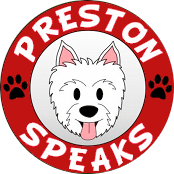There is so much talk about what food and diet to feed your cat and dog. Everyone seems to have an opinion and no one seems to agree. Since I want to make sure I’m a healthy dog in 2013, I decided I needed to get to the bottom of pet nutrition ASAP. To help me with this, I contacted my pal and senior nutritionist at P+G Petcare, Dr. E.K Alton. I asked him to give me a crash course on pet nutrition. Here are my cliff notes from our great call.
The Nutrition Needs of Every Dog and Cat are Unique
Even the types of food I need to stay healthy may be different than of my dog brother Elvis. For example, I am younger than him and our activity level is very different. I like to play, while Elvis loves to sleep, a lot. My brother cat Pibb is overweight (he calls it big boned) while my sister cat Pepper is underweight and a picky eater. This means mealtime at our house is a challenge. Everyone gets different foods and/or amounts and Mom and Dad have to make sure we eat only out of our bowls!
Speaking of unique, the nutrition requirements of a sledding dog is extreme! During a race, a sledding dog needs 12,000 calories a day! Oh my dog?!?! That is like you humans eating twenty-four McDonalds Big Macs in a day.
Some Pet Nutrition Facts You Need to Know
- Water – We have to have water and plenty of it! Actually it is the most important thing us pets need. It helps us maintain our body temperature, is a solvent for other important nutrients, and is a lubricant for our body.
- Protein – Since a dogs coat is 95% protein and 40% of our body is muscle, we need the protein so we can break it down into amino acids. In our food, this protein can come from meat, corn gluten, soybean, corn meal, and wheat gluten. Another super important fact I learned about my very distant cousin, the cat, is they HAVE to eat meat for the amino acid taurine they get out of it. If they don’t have taurine, they get very, very, sick. That is why you humans should never try to convert your cat to become an herbivore (not eating meat).
- Carbohydrates – This is a quick energy source for us. Technically, we don’t HAVE to have it to stay healthy, but when we eat carbs its gives us glucose for energy. Plus, it makes our food tastier and more palatable.
- Corn is not a filler – I know you have heard just the opposite before (we all have). So I asked Dr. Alton about the corn drama. He said it is an actually healthy for us doggies because it is a healthy carb. He said we shouldn’t just eat only corn, but when mixed with the right proteins it can keep us healthy. I also learned that the athletes of the dog world (sled dogs) are fed corn because it keeps them race ready.
- Dietary Fat – Yep fat is a great ingredient for us. The primary source of fat for us is animal meat, fish oils, and other types of oils. These fats give us the critically needed Omega 3 and 6.
- Beet pulp – This is another ingredient that is often misunderstood. Beet pulp actually helps us pets to maintain a healthy GI track. And you know what that means, much easier yard cleanup for the humans … hehehe. Plus, 70% of our immune system is found in the digestive track so we must take really good care of it!
Finally, the good doctor told me “balance is key” in pet food ingredients. So, now I know when I look at my food bag why all those ingredients are in there. I hope this helps you decode your bag as well!









While your facts may or may not be right about dogs, I can not say. But cats are obligate carnivores and have no nutritional need for carbohydrates. They lack the digestive enzymes for breaking down plant material fully and extracting the nutrients in them.
http://catinfo.org
http://feline-nutrition.org
Connie,
I agree that dogs and cats do not require carbohydrate in their diets however almost all commercial foods have this nutrient so most if not all us pets eat carbs daily. However, the largest proportion of carbohydrates in commercial pets foods is provided by starch (nonstructual polysaccharides). These dietary starches provide an economical, storable, and digestible energy source for both cats and dogs. These energy sources are efficiently digested by the activity of the pancreatic amylase (enzymes) in both cats and dogs. My source is Canine and Feline Nutrition, a Veterinary Medicine Nutrition textbook. I decided to go straight to vet academic textbooks for my research since many websites have conflicting information.